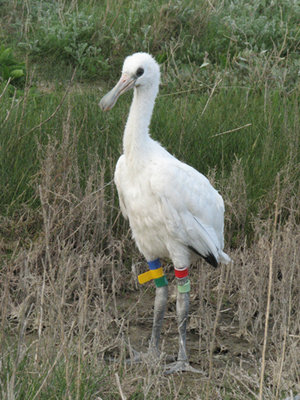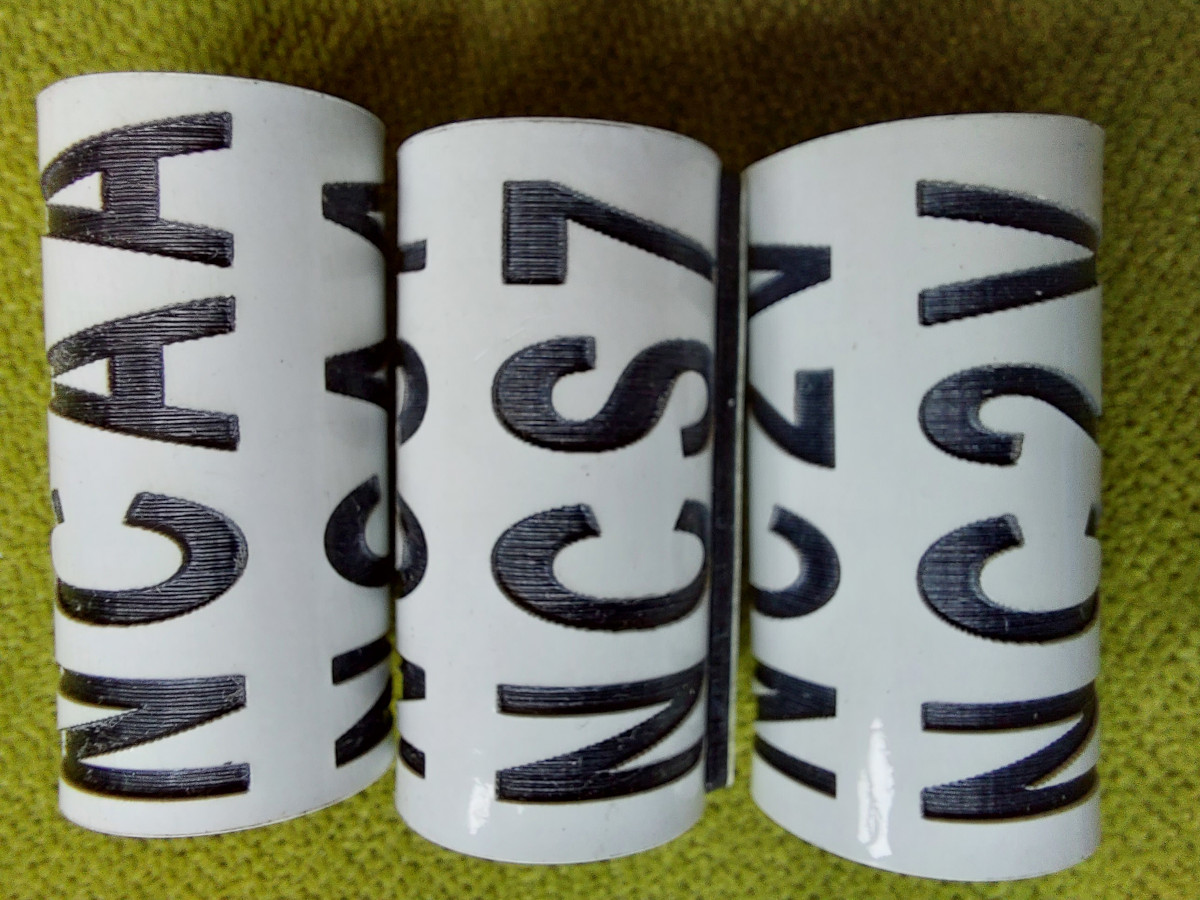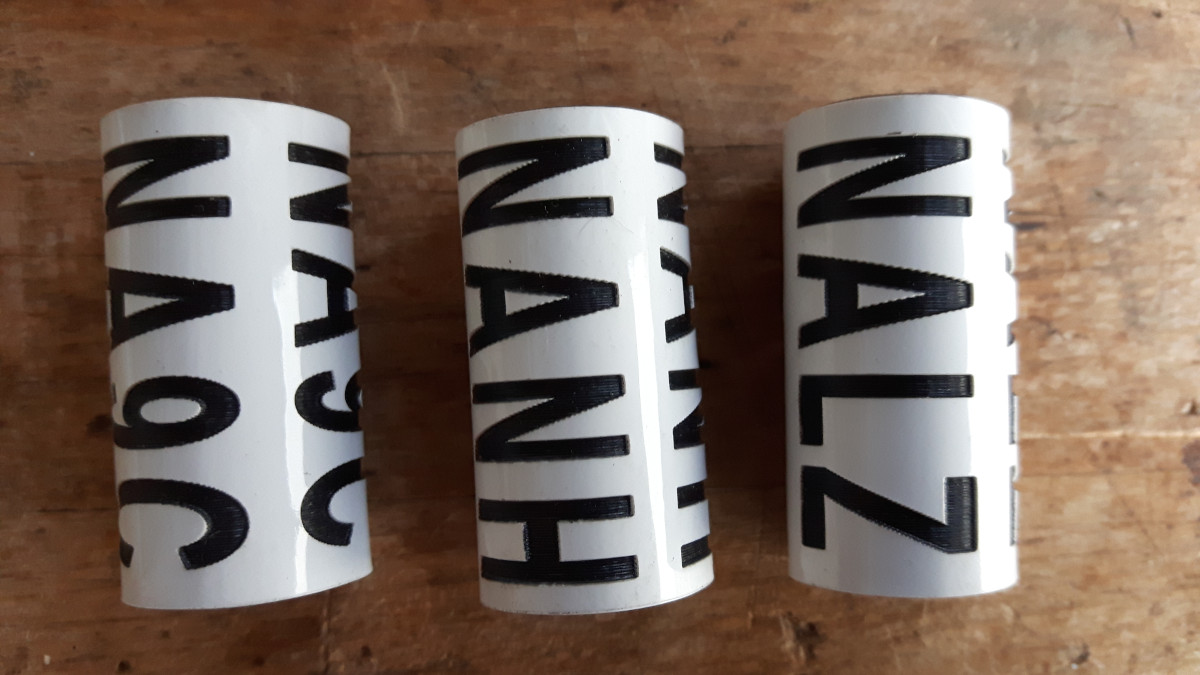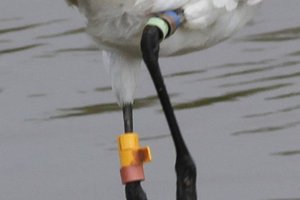The characteristics of Dutch rings
Young Spoonbills have been color ringed in the Dutch breeding colonies for over 30 years. The first color rings were white PVC rings with black bands on them. Then it became colored PVC rings, with 1 letter or 1 number and then it became rings with 2 letters and/or numbers. In 2007, the Workinggroup Spoonbill switched to the system with 4 colored rings, a metal ring and a flag. In 2019 we started with a white ring with 4 black inscriptions.
The color rings are always on the tibia (the part above the knee) and a metal ring is always part of the combination. Below we list all the combinations that have been used so far.
The population of spoonbills has now grown to such an extent that color ringing is also being done in Belgium, France, Spain, Portugal, Germany and Denmark. In addition, part of the spoonbill hatchlings of the subspecies balsaci in Mauritania are colour-ringed. We are happy to discuss these under the heading Foreign rings .
Reading order
The combinations of rings are read from left leg to right leg and from top to bottom. On the left is the bird’s left leg.
The second oldest system
On one leg a ring with an inscription of 1 letter/number (it stands upright) and a metal ring. On the other leg, or also a color ring with an inscription of 1 letter / number, or 2 color rings. Usually inscriptions on both legs.

A spoonbill with the rings Blue P, Orange Y a - B[P]/O[Y]a (metal ring under the orange ring, the orange ring is very discolored) - Photo: Tamar Lok
The second system
Color rings with two inscriptions. The inscription is the same on both legs, but the color of the color ring can be different! In principle, the inscription is read from top to bottom (except for incorrectly placed rings). Color ring combinations used are: red/black, blue/blue (this blue is very dark), red/yellow, lime/lime, blue/lime (clear blue), blue/white (clear blue), orange/orange, green/green , black/white, orange/blue, white/white.
Usually there is also a metal ring, and sometimes a tell-tale ring (color ring above or below the inscription ring). If the spoonbill stands on 1 leg, the animal can often still be identified if you see which leg has the visible color ring and the presence and position of a metal or tell-tale ring.

A spoonbill with the ring combination aB[KV]/B[KV] - Photo: Otto Overdijk
Before the slash is left, after the slash is right
a = aluminum (or metal) ring, which is here to the left and above the black ring
B = blue or black
Between [ ] is the inscription KV
The position of a is important
The third system
From 2007, ringing is done with color rings without inscriptions, with 3 rings on one leg and 2 rings on the other leg and a flag. Rings that can occur in the combination:
| metal ring (a) | a participates in the combination!! |
| yellow (Y) | |
| red (R) | |
| dark green (G) | |
| dark blue (B) | |
| light green/ lime (L) | |
| black (N) | N= Noir |
| light blue | P = Pale |
In Germany they got a dark green or lime flag until 2015 (lime only a few) and now a dark green one.
In Portugal they received a dark blue flag until 2015, but now a light blue flag.
In Belgium they received a blue flag until 2015, but now a black flag.
In Mauritania they get a red flag.
These were the colors from 2007 to 2015 including metal:

Five rings in the colors red, yellow, light green, dark green and dark blue - Photo: Werkgroep Lepelaar
These are the new colors from 2015 to 2019:

Six rings in the colors black, dark green, yellow, red, light blue and a metal ring - Photo: Werkgroep Lepelaar
So you can never see:
- black with lime
- black with dark blue
- lime with pale
- dark blue with pale
The color code is given in English.

A young spoonbill with the ring combination RaL/ByfG: From left to right and from top to bottom: Red metal Lime / Blue Yellowflag Green (Red metal Lime / Blue Yellowflag Green) - Photo: Inge Tielen
The new system
As of 2019, we use inscription rings, in addition to the metal ring. They are white rings with 4 black letters and/or numbers. We will start in 2019 with the N (the Netherlands) followed by 3 numbers and/or letters. So: NAAA, NA11, NB11, NSTV, NABN etc. We do not use: E, G, I, K, M, O, Q, W, Y and 8. The inscription ring goes around the left leg in the Netherlands.
White rings with four black letters or numbers - Photo: Werkgroep Lepelaar White rings with four black letters or numbers - Photo: Werkgroep Lepelaar White rings with four black letters or numbers - Photo: Werkgroep Lepelaar


Faded color rings
Some colors change over time. There are reports and photos of strongly discolored red rings. Lime sometimes turns a little beige.
Legs of a spoonbill with faded rings. The bottom ring, the red one, has faded a lot - Photo: Mark Hoekstein

A spoonbill with faded rings on its legs - Foto: Pieter van den Cruyce

A spoonbill with faded rings on its legs - Foto: Pieter van den Cruyce
Kleurringen melden
Have you seen a spoonbill with rings? Then we would like to hear from you. You can read how you can help us with this on the reporting rings page .

